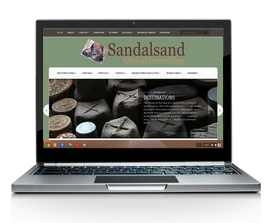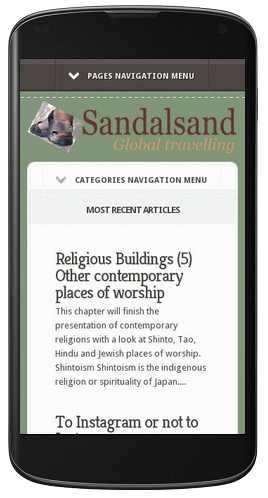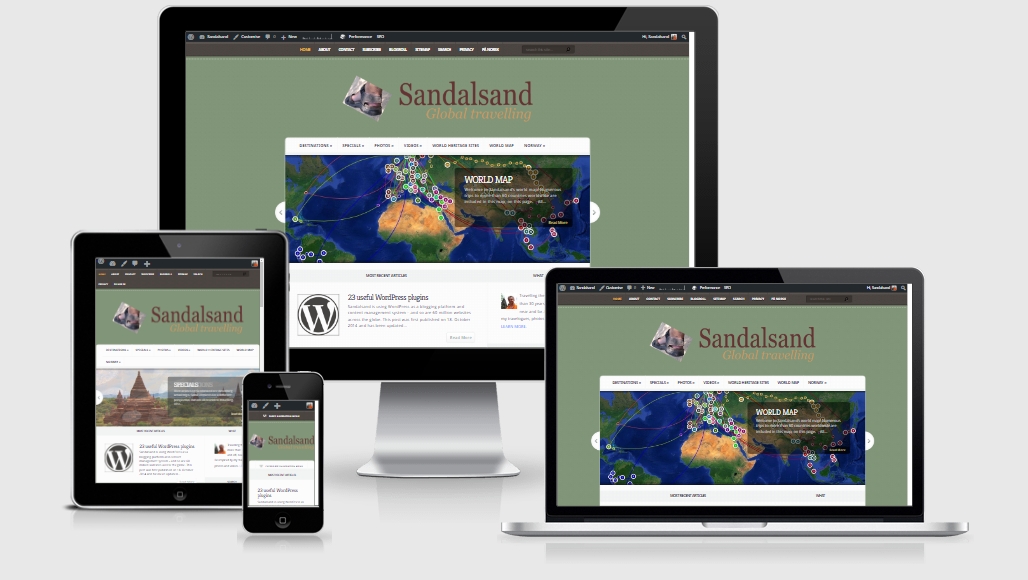Sandalsand is celebrating its first anniversary as an independent travel blog under its own .net domain. This is a look into the rear mirror at what happened prior to the launching. How to make your own travel blog?
The main purpose of the article is to explain to other potential bloggers my process of setting up a blog.
Background
I have actually had a travel blog since August 2011, called Sandalsand. It was hosted by Travellerspoint using their proprietary system. That worked fine, to a certain point. It was free of charge, I had the choice between a handful of layouts and the site was stable.
After two years I had made up my mind as to my future in travel blogging. I decided to continue. The big question was on which platform. I’m not a programmer and I had very little interest in becoming one. So I had to go searching for something that could save me a lot of HTML coding. I did not foresee a future as a professional blogger so I wanted to keep my expenses at the minimum.
When I made the move, it went swiftly.
What’s with the transition?
On October 16th 2013 I made a deal with the American firm iPage to register the domain Sandalsand.net on my behalf and to accommodate me in their web hotel. The same day I installed a free (blogging) software called WordPress on my new website, quite literally with a one-click button inside the iPage control panel. WordPress came with a default design (theme) but I went looking for others. Three days later I bought from Elegant Themes a theme I could identify with, “Aggregate”.
Less than two weeks later the main design elements had been completed and all my old articles (roughly 200-300) had been transferred from my previous site to the new platform.
On November 2nd, I announced the transition on both blogs. My new blog was launched and I deleted most of the content on Travellerspoint.
What research was done?
Before I got that far I set out with three tasks:
- I looked around the web for information
- and made a short list of pros and cons, and
- I concluded.
Here is the documentation, although it is now history.
Online resources about blogging, domains and webhosting
- How-to on blogging and all that: Link, Link, Link, Link, Link, Link, Link, Link, Link. Link, Link, Link, Link.
- There are many web hotels, here are some. I chose the latter: GoDaddy, HostGator, BlueHost; Ipage
- Export from Travellerspoint did not seem feasible, but this blogger offered a way: Export
What’s the story like one year later (click to see)?
Those links are still valid. There may be more web hotels out there, but I’m quite satisfied with iPage and their 24×7 customer support. All these service providers have a set of plans, depending on the traffic you get and the kind of website you are running. Prices vary, but I chose the basic one called “Essential”. It works.
WordPress is the de facto standard for bloggers so I skipped the search for others. One might consider Google’s Blogger, and I did actually set up a site there as well, just for testing. Read this comparison.
 For and against having my own domain
For and against having my own domain
Against (cons)
- Cost in money: This will cost tens or hundreds of dollars a year in purchases and to run.
- Cost in time, one-off: It will take long to migrate all content. I may consider not moving, just start anew – but this is basically no option.
- Cost in time, over time: Further development takes time but here I will just follow the stream of other WordPress users.
- General administrative overhead
- The learning curve
In favour (pros)
- Possibly increased revenue from ad sales
- The web hotels offer multiple subdomains for free. I might actually make a Norwegian language page to avoid mixing them. On the other hand I can also have a separate menu with articles only in Norwegian. In principle I can also have a separate blog in Norwegian, even on Travellerspoint.
- Nice to have
Conclusion
“Nice to have” won the argument.
What’s the story like one year later (click to see)?
For me there was no alternative to WordPress if I wanted a change. I did not want to go it alone, nor hire someone to make (from scratch) an expensive solution. The question was more like: «Travellerspoint with business as usual» or «Own domain on a WordPress platform»?
Setting up the blog cost me roughly $100, and I face yearly expenses of about $50. The Google Adsense ads I’m running won’t buy me many soup bowls but I am hoping to get even in economical terms.
There has been a sharp learning curve with a lot of frustration. Understanding WordPress up to a certain level is necessary. You will have to have a head for testing and technical problem solving. Lots of plugins (kind of like apps on your smartphone) add functionality but do not always live up to expectations. There are endless worries about SEO and load times. (I will in a separate article present the plugins I’m using.)
And yes: I have actually made a subdomain in Norwegian. It’s called «Sandalsand Norge» and was launched in June 2014. It looks very much alike this «mother» site.
It is still nice to have.
The look and feel of Sandalsand
I was inspired to choose a layout by browsing the 70 travel blogs I subscribed to at the time, in addition to the list of links above. Here are the results, specifying the name of WordPress (WP) theme in parentheses:
- LL World Tour (and sometimes Runaway Guide) (both use Thesis) and Arctic Nomad (Aggregate) are good on the upper part of the blog’s front page with the alternating images and intros. Also, check their horizontal menu with dropdowns for various subjects.
- Ordinary traveller is also very distinct, but a little boring? (Does not use WP)
- See the country list of Adventurous Kate (Streamline_30).
- OurTravelLifestyle is very appealing (does not use WP)
- The Road Forks (or maybe not, it’s messy) (does not use WP)
- Twenty-Something (20sTheme) and OverYonderlust (spectrum) are somewhat like Runaway Guide, but perhaps mostly because they are written by and for young people. These two have a cluttered menu system, but nice lists of earlier posts.
 Characteristics
Characteristics
There were not many I truly enjoyed. I have noticed that a left frame/column/menu is «out», the right menu has an “about” section at the top and various “widgets” down. One of the newest trends is to have a horizontal menu(s) with dropdown menu items at the top. Some even have two rows, which seems a bit too crowded.
Furthermore, there is often a large picture and even an image stream at the top of the screen. It is similar to Facebook’s, except that a set of images change incessantly and act as introductions to specific articles regardless of the order further down the page.
It gets a bit tiring with the image shifts, but the speed can probably be controlled. The first article will be pushed very far down the page. This is modern web design and I’m not sure I like it.
What I do know is that I currently use my entire front page to display multiple portals into my articles. This could have been avoided if Travellerspoint had a menu system, and not only offers a listing of the latest entries.
Conclusion
I liked the designs of LL World Tour and Arctic Nomad best. These two use themes that are not free. Thesis costs a few hundred dollars and is hardly worth it. Aggregate comes at 39 dollars per year with a free choice among 86 themes, delivered by a company named Elegant Themes. Many of the 86 look great.
I could have continued my search
WordPress offers some themes they have selected, including many free. I could have searched for other free themes on the web but I dropped it and went for the paid service of Elegant Themes. It was important to choose a theme that offered a responsive design that work equally well on all screens: smart phones, tablets and PC/Mac. My choice secured that.
What’s the story like one year later (click to see)?
I am still happy with my choice of theme. It is called Aggregate. It works very nice on all device platforms and across my two domains. I have spent some time fine-tuning the layout using the very easy options dialog.
The design is not the most recent from Elegant Themes, it may not be hip nor particularly fancy. On the other hand, neither am I.
Conclusion
So, finally in answer to my question in this post’s title I would like to conclude this:
If you are not sure of yourself and your blogging practice, try out the free hosting services at Travellerspoint, WordPress or Blogger. If you really want to own your own blog, find any large web hotel and “self host” your blog. Buy a domain and install WordPress. There are many theme-providers out there, but I can very much recommend Elegant Themes. They offer competitive prices, good support and they have a long range of exciting themes.
(I wrote and published this article in October 2014, based on a radical change the previous year. In 2019 I moved my sites onward, with a change of themes. Read that story too.)


